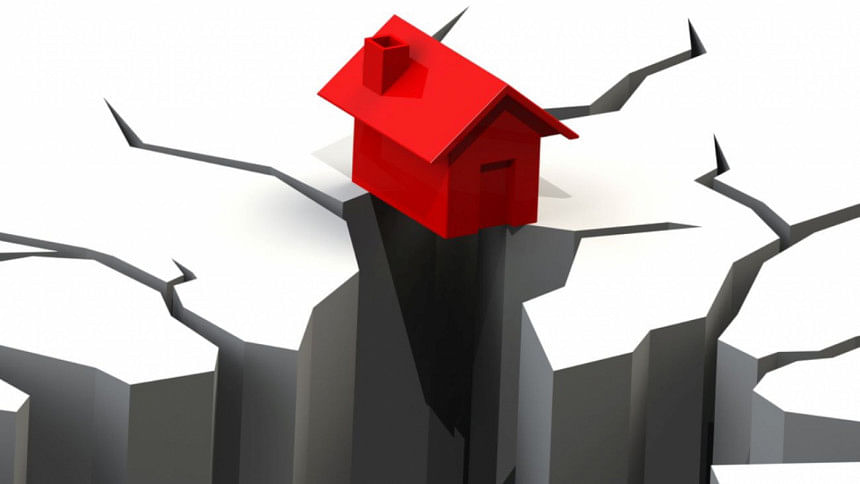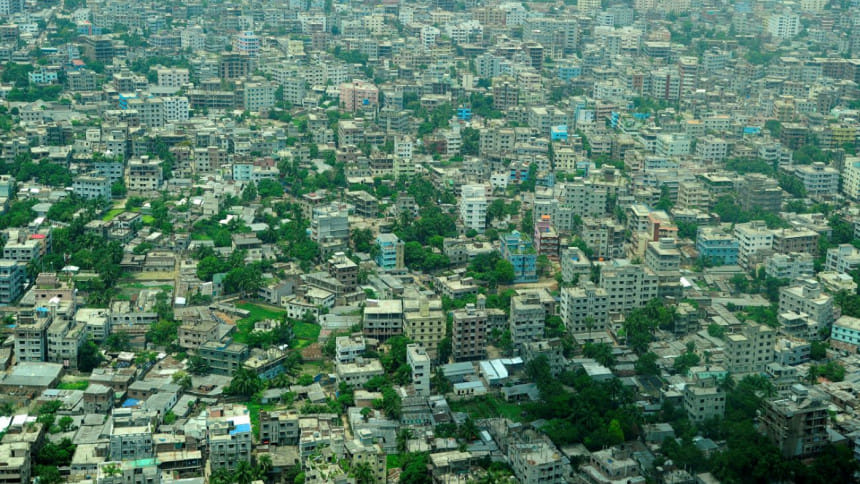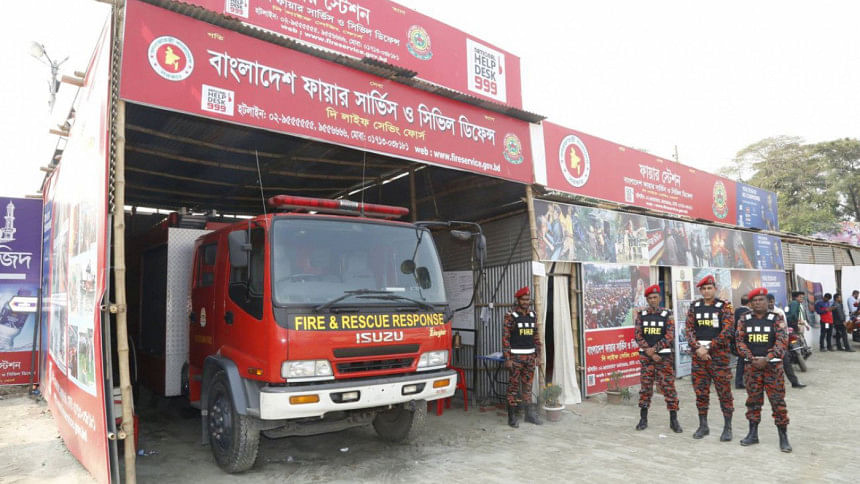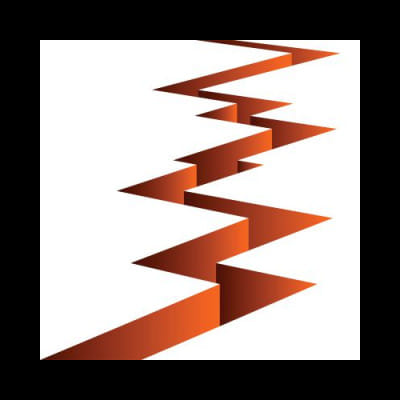The looming threat of earthquakes

We are trying our best to reach the status of middle-income country but an earthquake of magnitude of 7 or above can shatter that dream, prevent us from achieving the sustainable development goals, slow down growth, and push us down to a lower economic status.
We talk about earthquakes and then we quickly forget about them. We talk about earthquakes when a tremor jolts Bangladesh. We panic, we jump out of high buildings, we get injured, and we lose our family members and neighbours, we lose our lives. Media outlets rush to the scene, try to get a sound bite from those who are traumatised. A few talk shows cover the incident and we hear from experts, including senior government officials and practitioners about what to do, what the gaps are, what people should do, and what the government and non-government bodies should do. We feel that things have changed, become hopeful about having a better system, earthquake-resilient infrastructure and services.
But in reality, we tend to forget about the threat within a few weeks or months after the initial shock. We have become habituated with this post-earthquake dementia.
This is not to say that nothing has been done so far in Bangladesh regarding earthquake preparedness. A number of actions have been taken to enhance earthquake preparedness in Bangladesh. It ranges from equipping Fire Service and Civil Defence and Armed Forces Division; creating a large group of volunteers in major cities; conducting risk-mapping, zoning, and contingency planning of government departments; carrying out research to understand the magnitude of risks, and so on. However, there are many things that should be done immediately to build earthquake resilience.
Stanford University's Earthquake Disaster Risk Index 2010 ranks Dhaka among the 20 cities most vulnerable to earthquakes. Earthquakes will not only kill or injure people but also damage our export capacity and displace millions.

THE SCIENCE OF EARTHQUAKE RISKS AND THREAT TO BANGLADESH
Earthquake is a natural phenomenon which is created as a result of the sudden movement of rocks along the existing fault under the surface of the earth. The point on the surface of the earth directly above the focus of the earthquake is known as the epicentre. Earthquakes are powerful due to their strength. For example, a magnitude 7 earthquake releases 30 times more energy than a magnitude 6 earthquake and 300 times more energy than a magnitude 5 earthquake.
Densely populated Bangladesh sits at the juncture of three tectonic plates: the Indian plate to the west and southwest, the Tibet sub-plate to the north, and the Burma plate to the east. Moreover, the plate boundary between India and Burma passes through Bangladesh and these tectonic blocks were responsible for many earthquakes in the past. For us, some major faults should be noted due to their potential for giving way to devastating earthquakes: Bogra Fault, Tripura Fault, Dauki Fault and Assam Fault Zone. All of these can produce earthquakes of a magnitude of 7¬¬-8.5.
Among these fault zones, Dauki Fault has a history of creating high-magnitude seismic activities and impacts. The Dauki Fault has been active in the past and associated with the magnitude-7 Cachar Earthquake that struck Sylhet (Shilchar) in 1869. This fault has become inactive but it is considered as one of the major threats in Bangladesh.
The number of earthquakes has been increasing significantly over the last 20 years. From 1997 to 2018, more than 13 earthquakes above a magnitude of 4.5 have been felt in Bangladesh. Some of these had an epicentre within Bangladesh.
A recent study published in the science journal NATURE (Michael Steckleretal, 2016) showed that scientists have discovered new evidence of a hidden fault, which is buried under miles of river sediment. This could cause an earthquake of magnitude 8.2 to 9.0 in Bangladesh, and affect nearly 140 million people across the country, India and Myanmar. The destruction will not directly be due to the shaking. It will happen through changes in the courses of great rivers. Dhaka is within the zone of destruction.
Overall, the general consensus is that rapid urbanisation of Bangladesh has created a greater vulnerability to seismic events because urban planning and preparedness of the essential services have not been at par with the risks.

WHAT HAS BEEN DONE SO FAR IN BANGLADESH
Bangladesh has been widely regarded as the “champion of disaster management” globally. We have improved our management and mitigation measures against cyclones and floods. However, coping and mitigation strategies for earthquake have remained in the preliminary stage.
The Government of Bangladesh (GoB) has taken up a number of programmes to build earthquake response capacity. A good amount of search and rescue equipment has been bought with support from bilateral and multilateral donors. The Fire Service Department's fire-fighting capacity has been tremendously improved. Some of the good examples are: (I) Sector-specific risk assessment guidelines and mapping for earthquake for major cities (such as Dhaka, Chattogram, and Sylhet) and for medium and small urban areas, as well as for tsunami in 13 coastal districts; (ii) Seismic micro-zonation of Dhaka city, comprising probabilistic calculation of peak ground acceleration levels, estimation of predominant period of local amplification for micro-tremors, and amplification factor of each geomorphological type; (iii) Establishment of three new earthquake observatories, four seismometers and 30 accelerometers in earthquake vulnerable locations; (iv) Development of National Earthquake Contingency Plan by anticipating future earthquake risks, debris management plan and dead body management plan; (v) Development of Ministry and Sectors' Contingency Plan anticipating future risks of multi-hazards.
With the support of the Global Facility for Disaster Reduction & Recovery (GFDRR), the GoB has also developed Guidebooks on City Earthquake Risk Atlas, Legal and Institutional Frameworks, Dhaka Risk-Sensitive Land Use Planning, and an Information, Education, Communication and Capacity Building Roadmap as part of earthquake preparedness for Dhaka. Emergency Operating Centres (EOCs) have been identified, equipped and made functional during disasters like cyclones and floods.
The Comprehensive Disaster Management Programme (CDMP) Phase I and II of the Ministry of Disaster Management and Relief (MoDMR) has developed an urban risk assessment (URA) methodology which is widely used by different actors to develop urban risk assessment of Sylhet, Rangpur and parts of Dhaka and Chittagong. UNDP and GoB jointly developed seismic exposure level and contingency plan of Mymensingh city. The earthquake risk atlas of Chittagong City Corporation (CCC) was developed by CCC and NGOs with support from the European Commission Humanitarian Aid Office in 2005. The Bangladesh National Building Code has been revised by experts, and is now awaiting final approval of the authority. The concerned authorities with the support of structural experts and earthquake scientists have identified a number of vulnerable buildings in Dhaka city and drafted a debris management plan. MoDMR and NGOs are regularly organising national and international workshops and symposiums to highlight the risk of earthquakes and to raise public awareness. MoDMR with Public Works Department has retrofitted a couple of buildings in the Secretariat and other parts of Dhaka city. Yearly earthquake drills have been organised involving all stakeholders and international actors in Dhaka for the last decade.

WHAT STILL NEEDS TO BE DONE
Earthquake preparedness should be everybody's business. All stakeholders have a role to build an earthquake-resilient Bangladesh, not only the concerned authorities. Action needs to be taken at the individual, family and community levels to build a culture of earthquake resilience. Private sector, mass media, and social media have a critical role in enhancing awareness on earthquake preparedness.
Earthquakes are not only a national threat but also a regional threat. We should not only be satisfied by taking all necessary steps for earthquake preparedness in the country; we should also strengthen regional cooperation to tackle earthquake threats. Locating the epicentre and monitoring each shock may improve our understanding. However, it is important to focus on training and public awareness; integration of seismic resistance in infrastructures; development of safety systems in all public buildings; and introduction of local actor-based earthquake management.
First of all, it is important to implement existing policies and acts such as the Disaster Management Act without any delay. The rules of the Act need to be finalised and approved immediately.
The building code should be strictly enforced for all new construction. All constructed buildings should be investigated to measure earthquake resilience. In this regard, the private sector can play a big role.
Insurance should be made an essential requirement for all kinds of construction. If all the buildings are brought under an insurance scheme, the risk will be transferred to the private sector. Insurance companies will be responsible for ensuring standards and enforcing the building code for their own businesses. This will also make the real estate companies, contractors and building owners responsible for maintaining seismic resistance of constructions.
We have to: (i) Take measures to minimise gaps in urban planning to reduce the increasing risks. Steps need to be taken for complete decentralisation of urban governance and shifting power to elected city bodies for comprehensive planning and execution; (ii) Effectively utilise educational institutes to reduce the impact of urban risks. All educational institutes should be assessed for earthquake vulnerability and ensure investment for retrofitting vulnerable buildings; (iii) Ensure more effective resource allocation for earthquake preparedness and make earthquake risk reduction measures an integral part of all development programmes; (iv) Continue refresher trainings and orientation programmes for volunteers and ward disaster management committees and awareness-raising and preparedness activities at school to enhance knowledge and disseminate public announcements, alerts and education materials on earthquakes. Children are the change-makers and can bring an effective change in the mindset of their families about earthquake preparedness.
The youth in our society are the first responders in any emergency situation. We should look beyond vulnerable urban centres and reach out to the youth at the grassroots level around cities. They can be a valuable local resource for raising awareness in society on earthquakes and fighting disasters in times of need.
We should build: (i) A strong volunteer group and first responders in the least vulnerable areas surrounding risk cities. When the city is on the verge of collapse, those trained volunteers and first responders will be able to act fast and save lives in the devastated areas, and (ii) Capacity of our water-police and ability of fire service department to move through the waterways around all major cities and other earthquake vulnerable urban areas so that they can respond quickly during any big earthquake when the major roads are damaged or blocked by debris.
We need to have a plan for transport management. During a major earthquake, millions of people will try to leave the cities and urban centres and go to relatively safer locations, mostly to their semi-urban and rural homes. During the Nepal earthquake, the transport workers and owners' association played a key role to assist more than 700,000 people to leave Kathmandu city. We need to be prepared for such mass evacuation with proper planning and support system. We have to raise awareness and management capacity of the transport workers and owners.
Coordination and management of hundreds of groups during a mega-disaster become a nightmare for local and national governments. The Disaster Management Act and Standing Order on Disaster need to incorporate the scope of regional cooperation and facilitation of international search and rescue teams and responders during any major earthquake in Bangladesh. Our airport authorities and staff should be trained to handle record amounts of relief materials, personnel and cargos in the major airports. In case the airport collapses, alternative airports need to be made ready to facilitate the necessary international and regional support during a mega-earthquake.
All identified evacuation centres, locations and open spaces should be equipped with water supply, sanitation, faecal sludge management system, health care, energy supply and shelter to prevent post-earthquake deaths due to cold, waterborne diseases or lack of essential services. We would need trauma counsellors who will be able to provide psychosocial support to the survivors immediately after the devastation and help them recover quickly.
There is no early warning for an earthquake. But scientists have developed household level sensors which can track the first wave of earthquake energy and give a signal for second wave of energy which is stronger and can create major devastation. Depending on the location of the epicentre of an earthquake, people have anywhere between 30 seconds to a couple of minutes to get out of the buildings or take shelter in a safe location in the buildings. People should be instructed to install those systems in all government buildings, religious centres, shopping malls, industries and residential buildings.
Above all, all plans, preparedness and risk reduction measures for earthquake should be inclusive—ensuring that no one is left behind, that all persons with disabilities, children, women, third gender, elders are identified and taken care of, that they are involved in preparation of evacuation plan and drills.
Since the last most devastating earthquake in 1950 in the region, the population of this seismically active region has increased 50 times. Major cities like Dhaka, Chattogram, Sylhet, Mymensingh, Bogura, and Rangpur now have populations of more than several millions. Unless these measures are taken seriously and given adequate priority, earthquake preparedness will remain a distant dream for a country like Bangladesh. It's time we took earthquake preparedness seriously.
Shashanka Saadi is the Head of Emergency Preparedness & Response Programme, BRAC International.

 For all latest news, follow The Daily Star's Google News channel.
For all latest news, follow The Daily Star's Google News channel. 



Comments